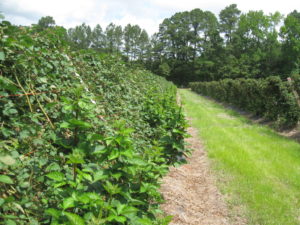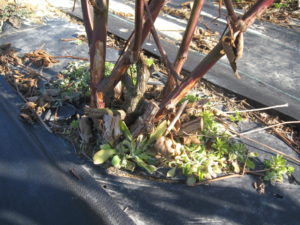Early spring is a good time to make the first herbicide application of the year in fruit plantings where a weed-free strip is maintained in the row (Figure 1). There are several options for fruit crops including both pre- and post-emergence herbicides. See the weed control chapter in the 2019-2020 Midwest Fruit Pest Management Guide for a complete list of registered products.
In most situations, there will be some emerged weeds present in the weed-free strip. These could be winter annuals, perennials, or recently germinated summer annuals. A post-emergence herbicide can be used to control these emerged weeds. Common broad-spectrum, post-emergence herbicides are glyphosate (Roundup, Touchdown, etc.), glufosinate (Rely, Forfeit, etc.), and paraquat (Gramoxone). Some fruit crops are extremely sensitive to glyphosate, specifically peaches and brambles. Avoid spraying glyphosate near stems/trunks that are “green” or not sufficiently covered with bark. Also, avoid spraying glyphosate on crops with actively growing suckers, as it could move into the rootstock and/or scion of the crop. Glyphosate works best on actively growing weeds. Activity will be slow in cooler conditions, and it may take a week or more to observe control.
Glufosinate and paraquat function more as contact herbicides, meaning that they kill plant tissue they come in contact with. With contact herbicides, coverage is important. Control will be quicker with these herbicides than glyphosate, but they may not be as effective in controlling perennial weeds. Low-hanging blueberry branches and stems of some thornless blackberry (Figure 2) varieties may be injured by these two herbicides, but yield is not usually affected. If you plan to use paraquat in this year, you must take an approved training course. More information on that is available here.
In order to avoid injury to brambles, a postemergence herbicide application should be made before primocane emergence.
For longer-term weed control, consider applying a pre-emergence herbicide as well. Pre-emergence herbicides can be tank-mixed with a post-emergence herbicide and applied together. Most pre-emergence herbicides will provide only 4 to 6 weeks of control as they break down in the environment. So, if applied in very early spring, they may not provide sufficient control of summer weeds (foxtail, barnyard grass, goosegrass, crabgrass, lambsquarters, ragweed, etc.). If those are weeds of concern, growers may want to delay application of pre-emergence herbicides until a bit later in the season. A good option is to apply a broad-spectrum, post-emergence herbicide, then come back in about 4 weeks with a second application of post-emergence tank-mixed with a pre-emergence herbicide. That should provide reasonably good season-long weed control. Another option is to apply a tank-mix of pre- and post-emergence herbicides now, and a delayed pre- plus post-emergence application later in the growing season or after harvest.

